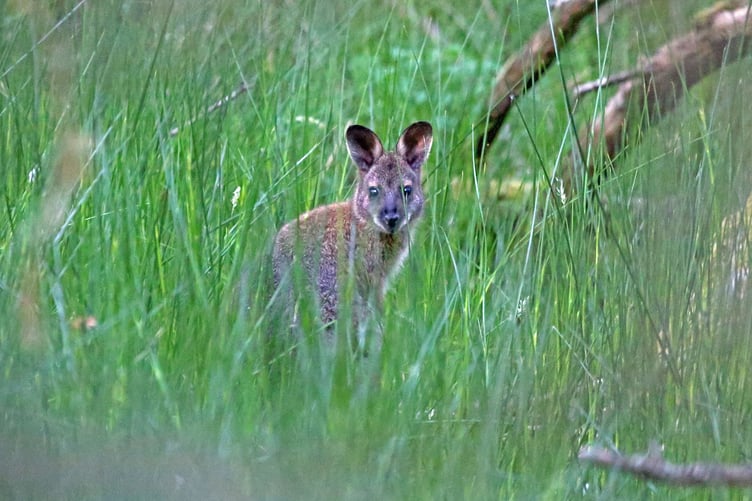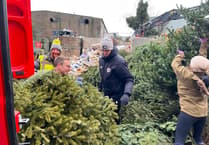Manx Wildlife Trust wants informed discussions about wallabies in the island.
A survey of the population found there are more than 560 red necked wallabies in the Ballaugh Curragh, which is an area of special scientific interest, and Ramsar site. It was conducted using a drone with a thermal imaging camera in January.
Leigh Morris, chief executive of the charity, says he is worried that the wallabies have come from a narrow gene pool, which could be problematic for their health.
‘I do know, from my background working at the Royal Zoological Society of Scotland with an office in Edinburgh Zoo, that you couldn’t breed wallabies unless there was a check on exactly what their bloodlines were,’ he said.
‘That was all controlled through a breeding programme through the European Association of Zoos and Aquariums and it’s done rigorously to avoid in-breeding.
‘I’ve seen a few photos taken of wallabies where they’re obviously blind. Their eyes are completely whited out and they can’t see.
‘Maybe that’s just what happens to wallabies as they get old, or maybe there’s an issue with the wallabies in the Isle of Man.
‘They escaped [the Wildlife Park] in the 60s and 70s and there were probably only a few animals, so it’s realistic to hypothesise that those animals have now multiplied up into hundreds across the whole island.
‘Maybe there are thousands, we don’t know. How has that narrow gene pool multiplied? Is that an issue? We don’t know.’
MWT chief executive Leigh Morris and Ben Harrower on the wallaby survey
Mr Morris explained that the MWT has ‘loads of questions’ about the habitat and the potential impact the wallabies are having.
He added: ‘What is certain is that if there are hundreds of wallabies they all eat something. That’s going to be kilos and kilos of plant material being eaten every day and there are differing opinions about that.
‘Some people would say that replaces the deer the island used to have years ago, so wallabies might now be a sustainable part of our ecosystem. The other side of the coin is that the wallabies are eating lots of our native plants and they’re decimating some of our Manx flora.
‘We don’t have precise evidence on that, and that’s the top line for MWT – we need to know.’
The chief executive felt it was important for the public to note that on the back of the population count, MWT isn’t asking for any action.
It only wants ‘proper informed discussions with the right people in the island’, including the Department of Environment, Food and Agriculture, which is the main landowner in the Curraghs, the farming community, and the Wildlife Park.
‘Let’s see if this number is happy and sustainable, or if we perhaps might need to manage the population,’ Mr Morris continued.
‘That’s not MWT saying we need to cull any. What we are saying, as a charity, is that we believe the population figure is significant and there needs to be potentially more research, but certainly a conversation about what steps we take next.
‘We’d love to carry out a full survey of the island and do that repeat survey in daytime in different areas to try and work out their behaviour.’
The wildlife charity released a position statement last year, explaining that it doesn’t wish to give a strong view in what should be done.
‘What we are clear about is we need to know more about the wallabies because you can’t have a proper discussion about the impact they might be having or their health without evidence,’ Mr Morris said.
Wallabies have been wild in the island for up to 60 years since they escaped from the Wildlife Park.
In the subsequent decades, they’ve grown into a sustainable population of feral wallabies.
Until now, it has never been clear how many were wild.
Mr Morris said: ‘I’ve sat in meetings were people have said there are only 20/30 wallabies in the island, so what’s all the fuss about?
‘On the flip side, people have said there are hundreds or even thousands and they’re doing a huge amount of damage to Manx nature.
‘We’ve started to carry out some research to get some more data so we can have informed discussions.
‘This research has come in a few ways. Our reserves manager, for example, has been taking photographic evidence of the nature reserves.
‘We’ve collected wallaby dung from all four seasons and sent that for DNA analysis to establish rigorously what plant material the wallabies are eating as herbivores.
‘Sadly, the DNA results were not conclusive. We got a little evidence of some plants they’re eating, which was a surprise, but we’re not going to release the whole results. We are thinking about having it done again.’
He added: ‘The next piece of research we’ve done, probably most interestingly, is we were keen to get a count of the wallaby population, an accurate figure.
‘In doing research, I came across Ben Harrower, who is an ecologist based in the UK, and he has surveyed wallabies. His main business is surveying large mammals.
‘Ben specialises in using a drone with a thermal imaging camera. We used our own core reserve funds and it cost just over £2,000.
‘I was out with Ben from about 10pm to 3am and we did a complete count of the Curraghs.
‘When we came back with a figure that was approaching 600 wallabies, I was amazed. I would not have guessed there would be as many wallabies as that in the Curraghs.
‘The greatest equivalent population in such an area Ben has seen is Muntjac deer in a part of England.
‘The count was so high that I felt this would be an interesting point of topic and we wanted to make sure the evidence was robust, so we repeated the count two days later.
‘We used the same methodology and we came back with a figure that was 10 different.’
More information can be found on the MWT website.




.jpg?width=209&height=140&crop=209:145,smart&quality=75)
Comments
This article has no comments yet. Be the first to leave a comment.